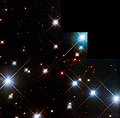Plik:Caldwell 76 (50291873217).jpg

Rozmiar pierwotny (1514 × 1492 pikseli, rozmiar pliku: 754 KB, typ MIME: image/jpeg)
| Plik Caldwell 76 (50291873217).jpg znajduje się w Wikimedia Commons – repozytorium wolnych zasobów. Dane z jego strony opisu znajdują się poniżej. |
Opis
| OpisCaldwell 76 (50291873217).jpg |
This image captures the shining stars in a portion of the open cluster Caldwell 76, also known as NGC 6231. It combines observations taken at ultraviolet, visible, and infrared wavelengths by Hubble’s Wide Field and Planetary Camera 2. This camera, before it was retired in 2009, was the highest resolution camera on any spacecraft capable of making observations in the far-ultraviolet range of the electromagnetic spectrum. Astronomers used the unique capabilities of the camera to survey Caldwell 76 and five other open clusters in the Milky Way with unprecedented clarity. By probing open clusters in the far-ultraviolet, astronomers were able to more efficiently find white dwarfs (the cores of stars that have shed their gaseous shell) that would be difficult to detect in the cluster using other methods. This was the first far-ultraviolet survey of open clusters in the Milky Way performed at such high resolution. Caldwell 76 is located in the constellation Scorpius, roughly 5,600 light-years from Earth. First discovered by the Italian astronomer Giovanni Battista Hodierna, it has an apparent magnitude of 2.6 and can be spotted with the naked eye when the skies are dark and clear. The cluster appears as a fuzzy patch of light to the unaided eye, but its individual stars can be resolved using a pair of binoculars. Caldwell 76 is easiest to observe during the winter in the Southern Hemisphere. It can be viewed from low latitudes of the Northern Hemisphere in the summer. The cluster is a popular target for southern observers because it is a part of the “False Comet” — a group of celestial objects that resembles a comet streaking across Scorpius. Caldwell 76 forms the head of the “comet,” while two other clusters and a cloud of gas and dust, called an emission nebula, form the tail. Credit: NASA, ESA, and J. Maiz Apellaniz (Centro de Astrobiologia [CSIC/INTA]); Processing: Gladys Kober (NASA/Catholic University of America) For Hubble's Caldwell catalog website and information on how to find these objects in the night sky, visit: <a href="https://www.nasa.gov/content/goddard/hubble-s-caldwell-catalog" rel="noreferrer nofollow">www.nasa.gov/content/goddard/hubble-s-caldwell-catalog</a> |
| Data | |
| Źródło | Caldwell 76 |
| Autor | NASA Hubble Space Telescope |
Licencja
- Wolno:
- dzielić się – kopiować, rozpowszechniać, odtwarzać i wykonywać utwór
- modyfikować – tworzyć utwory zależne
- Na następujących warunkach:
- uznanie autorstwa – musisz określić autorstwo utworu, podać link do licencji, a także wskazać czy utwór został zmieniony. Możesz to zrobić w każdy rozsądny sposób, o ile nie będzie to sugerować, że licencjodawca popiera Ciebie lub Twoje użycie utworu.
| Ten plik, opublikowany pierwotnie w serwisie Flickr przez NASA Hubble pod adresem https://flickr.com/photos/144614754@N02/50291873217, został sprawdzony 16 grudnia 2020 przez FlickreviewR 2, który potwierdził, że jest on tam dostępny na licencji cc-by-2.0. |
16 grudnia 2020
Podpisy
Obiekty przedstawione na tym zdjęciu
przedstawia
Jakaś wartość bez elementu Wikidanych
16 lis 2018
image/jpeg
f4f0178414c7899e9eb06006ff9517adb2a067ca
772 448 bajt
1492 piksel
1514 piksel
Historia pliku
Kliknij na datę/czas, aby zobaczyć, jak plik wyglądał w tym czasie.
| Data i czas | Miniatura | Wymiary | Użytkownik | Opis | |
|---|---|---|---|---|---|
| aktualny | 19:43, 16 gru 2020 |  | 1514 × 1492 (754 KB) | Szczureq | Transferred from Flickr via #flickr2commons |
Lokalne wykorzystanie pliku
Poniższa strona korzysta z tego pliku:
Globalne wykorzystanie pliku
Ten plik jest wykorzystywany także w innych projektach wiki:
Metadane
Niniejszy plik zawiera dodatkowe informacje, prawdopodobnie dodane przez aparat cyfrowy lub skaner użyte do wygenerowania tego pliku.
Jeśli plik był modyfikowany, dane mogą być częściowo niezgodne z parametrami zmodyfikowanego pliku.
| Orientacja obrazu | normalna |
|---|---|
| Rozdzielczość w poziomie | 72 punktów na cal |
| Rozdzielczość w pionie | 72 punktów na cal |
| Użyte oprogramowanie | Adobe Photoshop 21.2 (Macintosh) |
| Data i czas modyfikacji pliku | 14:45, 18 sie 2020 |
| Rozmieszczenie Y i C | Wyśrodkowane |
| Wersja standardu Exif | 2.32 |
| Data i czas zeskanowania | 11:41, 16 lis 2018 |
| Znaczenie składowych |
|
| Obsługiwana wersja Flashpix | 1 |
| Przestrzeń kolorów | sRGB |
| Bitów na próbkę |
|
| Metoda kompresji | nieskompresowany |
| Wysokość | 1492 px |
| Szerokość | 1514 px |
| Interpretacja fotometryczna | RGB |
| Próbek na piksel | 3 |
| Typ utworu | Observation |
| Data ostatniej modyfikacji metadanych | 10:45, 18 sie 2020 |
| Unikalny identyfikator oryginalnego dokumentu | xmp.did:2a0e8a17-b599-429b-a862-eef4fc89f248 |
